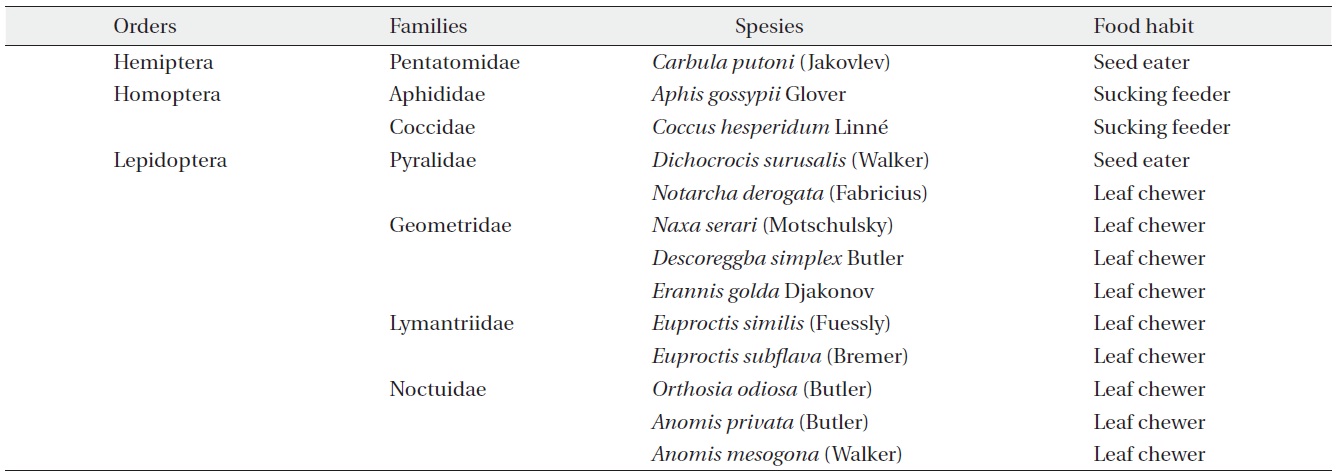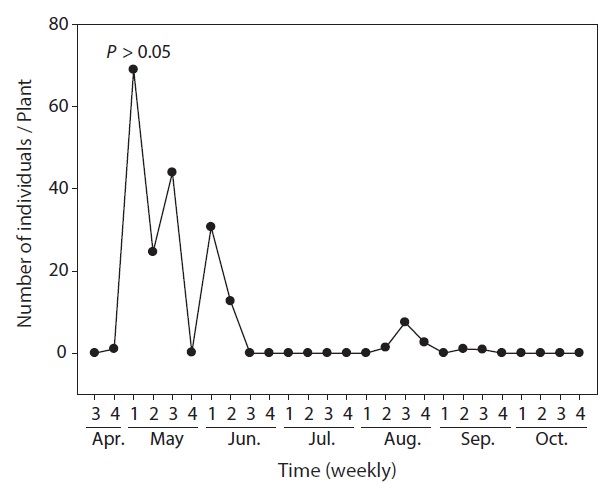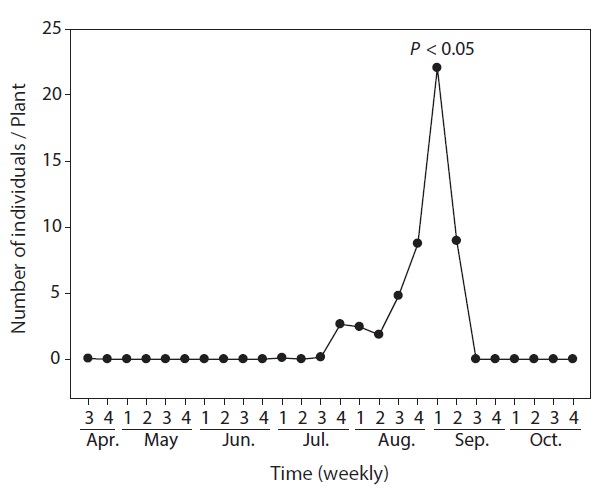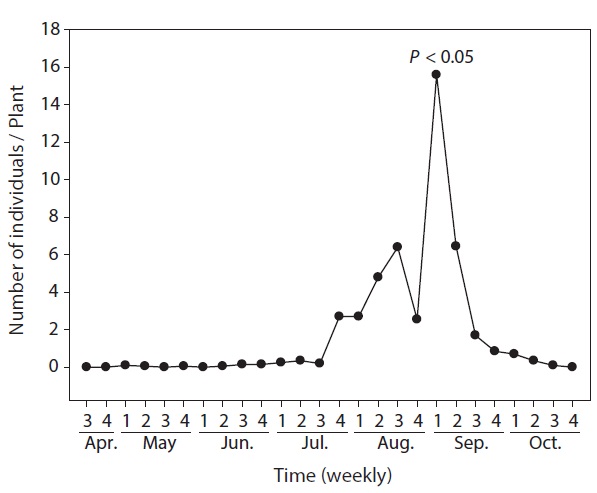Concentrated populations and industries have worsened the environments of urban areas. The deterioration of urban environments has in turn made urban dwellers aware of the importance of urban forests. Specifically, urban street trees are a part of the everyday life of urban dwellers, and they have various functions, such as improving the urban landscape, refreshing people by providing shade in summer, controlling weather conditions by absorbing solar radiation and through transpiration, as well as reducing noise and protecting pedestrians from automobiles (Lee 1996). There are about three million street trees across Korea. These include Prunus serrulata var. spontanea, Ginko biloba, Zelkova serrata, Metasequoia glptostroeboides, Platanus orientalis, Acer palmatum, and Pinus densiflora. P. serrulata var. spontanea comprise 39% of these street trees, followed by Lagerstroemia indica, Chionanthus retusa and G. biloba. These types of trees encompass most of the street trees in Korea (Kim et al. 2011). The H. syriacus and Forsythia koreana comprise 26.7% of shrub street trees, though cities and provinces are now working to plant more H. syriacus on streets (Kang and Shin 2000). The typical type of shrub street trees, the H. syriacus belongs to the genus Hibiscus of the Malvaceae family of the Malvales order. It is the national flower of South Korea and is a flowering plant that sheds its leaves and that can be found anywhere in South Korea. The flower is now cultivated by 44 nations, and there are about 200 species in total. About 150 species are now cultivated in South Korea (Song 2004). Thus far, only few types have been studied in terms of behavioral characteristics and in terms of the physiological features of their growing process. Moreover, the scope of these studies is narrow. Several studies investigated insects that harm the H. syriacus. Examples include insect community complex of H. syriacus (Lee 2005), insects pests and natural enemies of H. syriacus in Korea (Park et al. 2004), and scale insects (Stemorrhyncha) occurring on flowering plants in Korea (Kwon et al. 2005). Except for these studies, most other studies on this topic only extracted the ecological information of specific insects that are harmful to the H. syriacus rather than closely investigating the community structure of harmful insects and devising ways to eradicate them.
Therefore, this paper aims to formulate comprehensive data pertaining to the killing of insects that are harmful to the H. syriacus by providing the preliminary data about insects harmful to street trees, which constitute a microecosystem in urban areas. The paper also aims to identify the community structure of insects harmful to the H. syriacus, which is a representative shrub street tree.
The investigation took place in two locations where there were groups of H. syriacus shrubs in March of 2005.
The major insects that cause harm to the H. syriacus were investigated 26 times from the third week of April to the fourth week of October. Our investigation took place at Chu-dong and Jusan-dong in the Dong-gu part of Daejeon Metropolitan City (South Korea). These areas are surrounded by Lake Daecheong to the north, Ggot Peak (285.2 m) and Ggeogori Peak (231.7 m) to the east, and Mt. Seongjae (398.7 m) to the west. The areas are located to the west of Lake Daecheong, where 1,885 street trees, G. biloba, P. serrulata var. spontanea, and Z. serrata, were planted from Biryong-dong to the southwest to Hyopyeong- dong to the northwest with a distance of 15.10 km. The H. syriacus is planted along with these trees.
We randomly selected 10 out of 100 H. syriacus, the heights of which were under 250 cm which were growing in each of the locations used in our investigation. We investigated the insects on these shrubs every week from 10:00 to 17:00, when the insects were active. The insects observed during our investigation were classified as eggs, larvae, or imagoes. We also took pictures of the major harmful insects. In addition, they were classified into leaf chewers, sucking feeders, seed eaters, or predators. The larvae collected during our investigation were put on filter paper (90 mm #2; Advantec, Toyo, Japan) in a petri-dish (diameter 100 mm, height 15 mm) and supplied everyday with 1mL of distilled water to maintain the proper level of humidity. They were also provided with a clean H. syriacus leaf which had been cleansed with flowing water, after which they were cultivated in a thermo- hygrostat (VS-91G09MN, Vinsion Scientific Co., Bucheon, Korea) at a temperature of 27℃, a RH 70 %, lux of 12000 ± 100 at day, and with a temperature of 27℃, a RH 70%, lux of 0 at night, with a LD ratio of 14 to 10 of in order to identify the imagoes.
There were three orders, seven families, and thirteen species of insects harmful to H. syriacus (Table 1). One species one family of Hemiptera comprise 7.69 %, two species of two homopteran families comprise 15.38 %, and ten species of four Lepidopteran families comprises 76.92 %, thus showing that insects in the family of Lepidoptera made up the highest percentage of insect pests. When the harmful insects eating H. syriacus were classified according to which part of the flower they were eating, insects eating leaves account for 69.23 %, with nine species four families and one order. Insects sucking juice from leaves and stems comprised 15.38 %, with two species two families and two orders, while insects eating seeds comprised 15.38 %, with two species two families and two orders. The result concerning insect pests to H. syriacus was similar with that of Lee (2005), which showed sixteen species six families and three orders. It was also similar to the study of Park et al. (2004), which showed twelve species nine families and five orders. Meanwhile, Lee and Chung (1997) reported that there were 47 species seventeen families and four orders. However, they included the H. mutabilis in their study. Therefore, their composition of insect pests is necessarily different from the other results, which concentrated solely on insects directly harmful to H. syriacus. Kwon et al. (2005) reported that scale insects of the domestic flowers of Pulvinaria citricolar, Parlatoria theae and Pseudaonidia duplex cause damage to the stem of H. syriacus at the larvae stage and move to the leaves in order to lay their eggs at the imago stage. In our study, we found that Coccus hesperidum lives in environments where the temperature is high.
The Lepidoptera insect pests are as follows in: Naxa seraria, which causes considerable damage to Ligustrum obtusifolium, L. japonicum, Fraxinus rhynchophylla, Cornus controversa, Syringia vulgaris; Erannis golda, which damages Malus pumila, Rosa hybrid, Ulmus davidiana var. japonica, Quercus acutissima, Rhododendron schlippenbachii; Euproctis subflava and E. similis, which damage M. pumila, Pyrus serotina var. culta, Q. acutissima, Castanea crenata, Rosa hybrid, as well as causing caterpil-lar
dermatitis when their needles touch human skin (Kim and Rho 2006); Orthosia odiosa, which causes damage to Q. acutissima, M. pumila, Diospyros kaki and which completes its life cycle when it is given H. syriacus leaves to eat though only one entity was found in our investigation; Descoreggba simplex, which damages U. davidiana var. japonica, Robinia pseudoacacia, Rubus parvifolius, Rhus chinensis and Anomis mesogona, reported as the dominant species with A.privata by Park et al. (2004).
There are thirteen species of insects directly harmful to H. syriacus, but the occurrence of most of the insects was less than ten individuals, except for A. gossypii, D. surusalis, N. derogata and A. privata. Unlike other insects, the occurrence of these four insects was highly intensive for a specific period, causing much damage to H. syriacus. In addition, Lee (2005) reported that N. derogata and A. gossypii are the dominant harmful insects living on H. syriacus, while Park et al. (2004) reported that A. gossypii and A. mesogona are the most insects harmful to H. syriacus. Therefore, we considered these four insects as the insects causing the most harm to H. syriacus and therefore identified their seasonal distributions and ecological features.
A. gossypii is a harmful insect belong to Aphididae of Homoptera. It appeared once per H. syriacus from the fourth week of April to the second week of June, appearing the most at a rate of 69.05 per H. syriacus during the first week of May. It did not appear at all from the third
week of June to the first week of August, but appeared again at 1.35 per H. syriacus from the second week of August to the third week of September. However, it did not appear at all during the first week of September (Fig. 1). A. gossypii is found around the world. It lives on 60 species of host plants in Florida in the US and on 700 species of host plants around the world (Capinera 2001). Nearly 50 species plants have been discovered to be its host plants in South Korea. It causes damage to H. syriacus by sucking juice, but causes more damage by transferring as many as 45 species of viruses (Paik 1972). According to the study of Yu et al. (1976), A. gossypii overwinters as an egg and then hatches as an imago without wings close to April of the next year. It then becomes an imago with wings by means of parthenogenesis, after which moves to Punica granatum, Gossypium indicum, vegetables using them as intermediate host plants. Our study confirmed this by identifying that they appeared from April to early May. In addition, A. gossypii flies to H. syriacus in the middle of September to overwinter (Lee and Chung 1997); our study confirmed this by identifying that it occurred from the middle of August to the middle of September. In short, numerous A. gossypii occur from April to May, deteriorating the visual effect of H. syriacus. Considering the fact that A. gossypii lays its eggs on Catalpa ovata and H. syriacus (Capinera 2001), it is necessary to understand the characteristics of the insect in order to carry out biological and chemical control efforts that are effective.
D. surusalis is a harmful insect belongs to Pyralidae of Lepidoptera. It appeared at a rate of 0.05 per H. syriacus during the third week of April and regularly appeared
from the first week of July to the second week of September. However, it did not appear at all during the second week of July. Its occurrence was the most frequent during the first week of September, at 22.05 (Fig. 2). D. surusalis initially appeared in April and was considered as having overwintered. Its larva causes damage to the flower buds and ovaries of H. syriacus, hindering H. syriacus from flowering and creating mature seeds. The period of flowering of H. syriacus is from the middle of July to October, and the peak time of H. syriacus is from the end of July to the middle of August. D. surusalis appears during the period of flowering of H. syriacus by following its ecological features. The results of our study are consistent with this; the insect’s occurrence increased from July, but it disappeared in late September. Therefore, we think that it occurs once per year and continuously causes considerable damage by moving through ovaries or flower buds. An effective prevention method should be established because D. surusalis is highly damaging in a very short time, especially during the flowering period of H. syriacus.
N. derogata is a harmful insect of Pyralidae of Lepidoptera that initially appeared at a rate of 0.1 per tree during the first week of May, after which it continuously appeared until the third week of October. Its occurrence was most frequent at a rate of 15.6 per tree during the first week of September (Fig. 3). N. derogata is the worst enemy of H. syriacus. Its larva rolls a H. syriacus leaf up then damages the leaf from the inside. Hence, a young larva damages a leaf by following its vein, whereas, an old larva damages the entire leaf by rolling it up (Lee and Chung 1997). N. derogata and A. privata do not occur at any specific pe-
riod. Rather, they initially occur in May and continuously occur until late September, the season of overwintering. N. derogata occurs about 2~3 times per year during June and July or during August and September, causing much damage, especially during August and September. A H. syriacus was attacked by 32 N. derogata insects and withered due to the damage invoked by them.
A. privata is a harmful insect of Noctuidae of Lepidoptera. A. privata is distributed in Korea, Japan, China, Southeast Asia, India, Australia and North America (Kononenko et al. 1998). It initially appeared at a rate of 0.05 per tree during the first week of May and continuously occurred from the fourth week of June to the fourth week of October. Its occurrence was most frequent at 2.30 per tree during the third week of September (Fig. 4). A. privata is the worst enemy of the major insects harmful to H. syriacus; it eats the entire leaf of H. syriacus, only leaving the main vein of the leaf. Like N. derogata, it occurs initially in May, appearing until late October, unlike the other harmful insects. Also, it occurs two or three times per year. Its young larva damages the leaf by sticking to the back of the leaf, changing its color from green to brown after a certain amount of time passes, while an old larva causes damage to the leaf by sticking to the stem. Park et al. (2004) reported that A. mesogona, which is an insect in the same family of A. privata, eats 4.7 leaves out of 100 leaves in May and 80.7 leaves out of 100 leaves in August. In our study, six A. privata insects were found in one tree, but it was identified that only a small number of the insects actually ate a large number of leaves.









